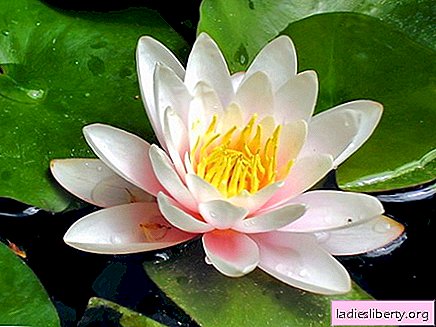
Water Lily (Water Lily) - General Description
Water lily (water lily, Nymphaeáceae) is a perennial herbaceous aquatic plant belonging to the class of water lilies, or nymphaea. Dark brown thick rhizome (up to 2.5 m in height) is covered with a small number of petioles of leaves. Due to the whole system of air channels, the plant is respected and held on the surface during strong winds.
Leaves are floating, rounded in shape, with a diameter of up to 30 cm, change color with age, from reddish to dark green and reddish-purple. Single large flowers of white color, in diameter up to 20 cm. The calyx, consisting of 3-5 petals, has a strong gentle smell. It blooms throughout the summer. Fruits of green color, spherical in shape, ripen under water.
Water lily (water lily) - types and places of growth
According to the depth of immersion and the diameter of the leaves, the types of water lilies are very different - from mini-plants to giant plants. There are about 50 species of these plants. The most common species are white, snow-white, tetrahedral, tuberous, fragrant, dwarf, hybrid, blue, and tiger. It grows in the European part of Russia, western and eastern parts of Siberia, Transcaucasia and Central Asia. Most often it can be found in the forest zone and in the steppes. In addition, the water lily is used for decorative purposes in landscape design. White water lily can exist in stagnant and flowing water bodies; it prefers sunny places.
Water lily (water lily) - healing properties
Unfortunately, the use of this plant in traditional methods of medicine has not been very active lately, although the composition is suitable for use in a number of diseases ... It can be used as a sedative for neurosis and insomnia, as a painkiller for rheumatism and neuralgia, and as an antipyretic for fevers.
Water lily leaves are used as an external anti-inflammatory agent, roots and rhizomes can help with inflammatory processes of the skin. With colds, the root of the plant can be used instead of mustard. Water lily is more widely used in alternative methods of treatment. Tincture of the root, since the time of Avicenna, has been used for various tumors of the spleen, including malignant tumors.
Water lily (water lily) - dosage forms
In the composition of the rhizome of this medicinal plant, starch, proteins, sugars, essential oil, alkaloid nymphine are found. Flowers, stems and rhizomes also contain essential oil, but in much smaller sizes. Nymphaline glycoside, obtained from flowers, can have a psychoactive effect, that is, affect the human nervous system.
Water lily (water lily) - recipes
1. Cosmetic product:
It is made from fresh petals, which in the amount of 2 tablespoons are filled with water (about half a liter) and boiled for 15 minutes. The broth is added to the bath or as a wipe as a bleaching agent.
2. Hypnotic and antipyretic drugs:
Boil fresh petals of a water lily in a glass of water and insist for three hours. Drink half a glass.
3. The cure for heart weakness:
It is used as part of the collection: 4 tablespoons of the petals of a white water lily and 4 tbsp. tablespoons of blood-red hawthorn insist for 2 hours, previously brought to a boil.
Water lily (water lily) - contraindications
Medications using water lily should be taken with caution in people with low pressure, since a water lily slightly reduces pressure.
Water lily (water lily) - interesting facts
- In honor of the English Queen Victoria, the largest water lily of the world Victória was named. The diameter of its leaves reaches two meters, this allows you to withstand weight up to 50 kilograms (for example, the weight of a teenager). Flowers are amazingly capable of changing color and aroma.
- In India, since ancient times, a drug has been used to subjugate the will, prepared from the buds of a water lily flower. For some time a person experiences hallucinations, and can be affected. Symptoms disappear after two hours.
- A huge number of myths and legends associated with mermaids, elves have been compiled about this plant in different countries. According to one belief, a water lily should not be bought, since it can transmit the negative energy of the seller along with it.
Comments











